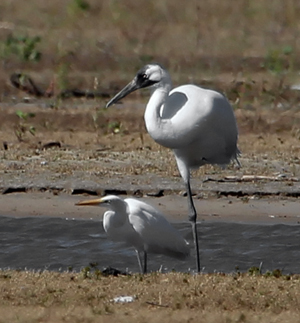by John Shackford

Oklahoma is in the middle of the flight path that Whooping Cranes (Grus americana) take every fall and spring as they come and go from their breeding grounds far to the north of us, at Wood Buffalo National Park, in northeastern Alberta and southern Northwest Territories, Canada, and their wintering grounds at Aransas National Wildlife Refuge on the Texas coast near Corpus Christi. I believe there has been at least 1 record of at least 1 bird seen flying near Lake Hefner a number of years ago now, but I do not recall details of the report. One of the Whooping Cranes most frequent stopping points on their migration between their breeding and wintering grounds is the Great Salt Plains National Wildlife Refuge in northwestern Oklahoma, about 90 miles to our NNW; late October and early November are some of the best times to see them there in the fall.
Many of you no doubt are familiar with the broad outline of conservation efforts on behalf of this endangered species, but here I want to take a bit closer look. The Whooping Crane has come a long way from its all time low number of 15 birds in the 1940s. The total wild population as of May 2011 was 414 birds, with 103 breeding pairs; the total captive population for the same time period was 157, with 34 pairs, held at 12 locations, several of them zoos. This is a total population of 571 birds as of May 2011.
Most of the Whoopers in the primary wild population spend the winter at Aransas NWR in Texas, but a number of birds from this “flock” are now being found at other locations in 8 Texas counties. This is a good sign, I believe, because this wild population apparently is starting to spread out beyond the bounds of its “last ditch” wintering habitat of the past at Aransas NWR.
In addition to the primary wild flock, 3 secondary wild flocks have been established, 2 in Florida and 1 in Louisiana. One of the Florida flocks, in central Florida is non-migratory, the 2nd flock migrates between Florida and Wisconsin; 2 chicks were hatched in the wild in Wisconsin in 2010—great news. The wild flock in Louisiana is non-migratory and is located at White Lake, in Vermilion County, southwestern Louisiana: here 10 young Whoopers were released into the wild in February 2011. One additional attempt to establish another wild migratory flock failed: Whooping Crane eggs were placed in Sandhill Crane nests at Gray’s Lake National Wildlife Refuge, in southeastern Idaho. The young from these eggs migrated to Bosque del Apache National Wildlife Refuge in New Mexico, but these Whoopers would select only Sandhill Crane for mates and also had high mortality rates, so the effort was discontinued.
J. W. Preston (1893, Some Prairie Birds, as cited in Bent, 1963, Life Histories of North American Marsh Birds) said the nests of the Whooping Crane “…were formed of soft grass gathered together in a firm heap about 11/2 feet high, and placed on firm sod, out of water, but very near it.” Whooping Cranes usually lays 2 eggs, but rarely 1 or 3. A number of photographs on the wintering grounds show a single Whooping Crane family made up of 2 adults and 1 young of the year, suggesting that only 1 of the 2 chicks that normally hatch in a nest survives until winter. It takes 4-5 years before the young reach breeding maturity. Whooping Cranes establish quite large territories on both breeding and wintering grounds, average territory size being about 1.6 sq miles.
The flight path of the Whooping Crane is similar to many other birds that fly through Oklahoma along the central flyway—sandpipers, ducks, geese, gulls, terns, in addition to the Whooping Cranes. We in Oklahoma have a lot to be thankful for.
